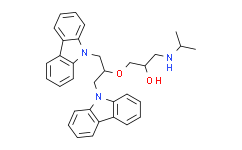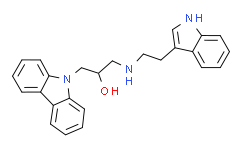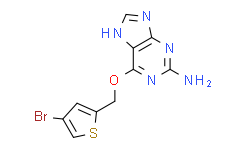| 中文名称: | DC_517 | ||||
|---|---|---|---|---|---|
| 英文名称: | DC_517 | ||||
| 别名: | DC-517;DC_517 | ||||
| CAS No: | 500017-70-9 | 分子式: | C33H35N3O2 | 分子量: | 505.65 |
| CAS No: | 500017-70-9 | ||||
| 分子式: | C33H35N3O2 | ||||
| 分子量: | 505.65 | ||||
包装规格:
1mg 5mg 10mg in glass bottle
产品简介:
一种 DNMT1 抑制剂,IC50 和 Kd 值分别为 1.7μM 和 0.91μM。
溶解性:
溶于DMSO(≥50mg/mL)
储备液保存:
-80°C, 2 years
-20°C, 1 year
-20°C, 1 year
体内实验:
1、请依序添加每种溶剂: 10% DMSO→40% PEG300→5% Tween-80→45% Saline
Solubility: ≥ 3.25 mg/mL (6.43 mM); 澄清溶液
此方案可获得 ≥ 3.25 mg/mL(饱和度未知)的澄清溶液。
以 1 mL 工作液为例,取 100 μL 32.5 mg/mL 的澄清 DMSO 储备液加到 400 μL PEG300 中,混合均匀;再向上述体系中加入 50 μL Tween-80,混合均匀;然后再继续加入 450 μL 生理盐水 定容至 1 mL。
2、请依序添加每种溶剂: 10% DMSO→90% (20% SBE-β-CD in Saline)
Solubility: 3.25 mg/mL (6.43 mM); 悬浊液; 超声助溶
此方案可获得 3.25 mg/mL的均匀悬浊液,悬浊液可用于口服和腹腔注射。
以 1 mL 工作液为例,取 100 μL 32.5 mg/mL 的澄清 DMSO 储备液加到 900 μL 20% 的 SBE-β-CD 生理盐水水溶液 中,混合均匀。
3、请依序添加每种溶剂: 10% DMSO→90% Corn Oil
Solubility: ≥ 3.25 mg/mL (6.43 mM); 澄清溶液
此方案可获得 ≥ 3.25 mg/mL(饱和度未知)的澄清溶液,此方案实验周期在半个月以上的动物实验酌情使用。
以 1 mL 工作液为例,取 100 μL 32.5 mg/mL 的澄清 DMSO 储备液加到 900 μL玉米油中,混合均匀。
<1mg/ml表示微溶或不溶。
普西唐提供的所有化合物浓度为内部测试所得,实际溶液度可能与公布值有所偏差,属于正常的批间细微差异现象。
请根据产品在不同溶剂中的溶解度选择合适的溶剂配制储备液;一旦配成溶液,请分装保存,避免反复冻融造成的产品失效。
Solubility: ≥ 3.25 mg/mL (6.43 mM); 澄清溶液
此方案可获得 ≥ 3.25 mg/mL(饱和度未知)的澄清溶液。
以 1 mL 工作液为例,取 100 μL 32.5 mg/mL 的澄清 DMSO 储备液加到 400 μL PEG300 中,混合均匀;再向上述体系中加入 50 μL Tween-80,混合均匀;然后再继续加入 450 μL 生理盐水 定容至 1 mL。
2、请依序添加每种溶剂: 10% DMSO→90% (20% SBE-β-CD in Saline)
Solubility: 3.25 mg/mL (6.43 mM); 悬浊液; 超声助溶
此方案可获得 3.25 mg/mL的均匀悬浊液,悬浊液可用于口服和腹腔注射。
以 1 mL 工作液为例,取 100 μL 32.5 mg/mL 的澄清 DMSO 储备液加到 900 μL 20% 的 SBE-β-CD 生理盐水水溶液 中,混合均匀。
3、请依序添加每种溶剂: 10% DMSO→90% Corn Oil
Solubility: ≥ 3.25 mg/mL (6.43 mM); 澄清溶液
此方案可获得 ≥ 3.25 mg/mL(饱和度未知)的澄清溶液,此方案实验周期在半个月以上的动物实验酌情使用。
以 1 mL 工作液为例,取 100 μL 32.5 mg/mL 的澄清 DMSO 储备液加到 900 μL玉米油中,混合均匀。
<1mg/ml表示微溶或不溶。
普西唐提供的所有化合物浓度为内部测试所得,实际溶液度可能与公布值有所偏差,属于正常的批间细微差异现象。
请根据产品在不同溶剂中的溶解度选择合适的溶剂配制储备液;一旦配成溶液,请分装保存,避免反复冻融造成的产品失效。
靶点:
DNMT1:0.91 μM (Kd);DNMT1:1.7 μM (IC50)
体外研究:
DC_517 is a DNA methyltransferase 1 (DNMT1) inhibitor, with an IC50 and a Kd of 1.7 μM and 0.91 μM, respectively. DC_517 (1.25, 2.5, 5, and 10 μM) potently inhibits the proliferation of HCT116 (human colon cancer) and Capan-1 (human pancreatic adenocarcinoma cells) after treatment for 24, 48, and 72 h. DC_517 (0, 0.75, 1.5, and 3 μM) also dose-dependently induces apoptotic cell death in HCT116 cells.
保存条件:
-20℃
注意事项:
1、为了您的安全和健康,请穿实验服并戴一次性手套操作。
2、以上信息仅做参考交流之用。
2、以上信息仅做参考交流之用。
UN码:
HazardClass:
危害声明:
安全说明:
搜索质检报告(COA)
参考文献 & 客户发表文献
本计算器可帮助您计算出特定溶液中溶质的质量、溶液浓度和体积之间的关系,公式为:
质量 (g) = 浓度 (mol/L) x 体积 (L) x 分子量 (g/mol)
摩尔浓度计算公式
用本工具协助配置特定浓度的溶液,使用的计算公式为:
开始浓度 x 开始体积 = 最终浓度 x 最终体积
稀释公式
稀释公式一般简略地表示为:C1V1 = C2V2 ( 输入 输出 )










